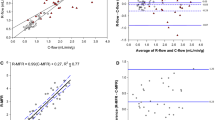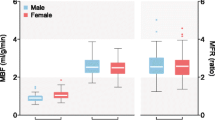Abstract
Flow quantitation with nitrogen-13 ammonia (13NH3) and positron emission tomography (PET) is dependent on an accurate blood time-activity curve. This is conveniently derived from the PET images by drawing a region of interest in the left ventricular cavity. The blood time-activity curve obtained in this way, however, may contain spillover from the myocardial wall. The purpose of this study was to analyse the effect of wall to blood pool spillover. Additionally, we analysed the application of a left atrial input function. Using computer simulations, we investigated the effect of spillover from the myocardial wall to the left ventricular input function and the effect of time delay on the left ventricular input function. An oxygen-15 carbon monoxide PET study of seven normal volunteers was used to investigate possible recovery issues regarding the left atrial input function. Finally, 13NH3 studies of 31 normal volunteers during rest and dipyridamole stimulation were analysed using either a left atrial or a left ventricular input function. The simulation studies showed that myocardial wall to blood pool spillover causes a considerable underestimation of the regional blood flow values in hyperaemic flow studies. Neither time delay nor recovery issues prevent flow quantitation with a left atrial input function. The 13NH3 studies revealed no significant difference between the resting blood flow values, whereas the hyperaemic blood flow values were underestimated by 8% (P<0.01) on average (up to 40% individually) when using a left ventricular input function compared with a left atrial input function. Spillover of activity from the left ventricular wall to the blood time-activity curve is of importance in hyperaemic flow studies using 13NH3. Application of a left atrial input function is a possible solution to these issues.





Similar content being viewed by others
References
Kuhle W, Porenta G, Huang SC, et al. Quantitation of regional myocardial blood flow using13N-ammonia and reoriented dynamic positron emission tomographic imaging. Circulation 1992; 86:1004–1017.
Bol A, Melin JA, Vanoverschelde J-L, et al. Direct comparison of [13N]ammonia and [15O]water estimates of perfusion with quantification of regional myocardial blood flow by microspheres. Circulation 1993; 87:512–525.
Nitzsche EU, Choi Y, Czernin J, Hoh CK, Huang SC, Schelbert HR. Noninvasive quantification of myocardial blood flow in humans. A direct comparison of the [13N]ammonia and the [15O]water techniques. Circulation 1996; 93:2000–2006.
Weinberg IN, Huang SC, Hoffman EJ, et al. Validation of PET-acquired functions for cardiac studies. J Nucl Med 1988; 29:241–247.
Rosenspire KC, Schwaiger M, Mangner TJ, Hutchins GD, Sutorik A, Kuhl DE. Metabolic fate of [13N]ammonia in human and canine blood. J Nucl Med 1990; 31:163–167.
Krivokapich J, Smith GT, Huang SC, et al. N-13 ammonia myocardial imaging at rest and with exercise in normal volunteers: quantification of absolute myocardial perfusion with dynamic positron emission tomography. Circulation 1989; 80:1328–1337.
Herrero P, Hartman JJ, Senneff MJ, Bergmann SR. Effects of time discrepancies between input and myocardial time-activity curves on estimates of regional myocardial perfusion with PET [see comments]. J Nucl Med 1994; 35:558–566.
Smith GT, Huang SC, Nienaber CA, Krivokapich J, Schelbert HR. Noninvasive quantification of regional myocardial blood flow with N-13 ammonia and dynamic PET. J Nucl Med 1988; 29:940.
Gambhir SS, Mahoney DK, Huang SC, Phelps ME. Symbolic Interactive Modeling Package and Learning Environment (SIMPLE), a new easy method for compartmental modeling. Proceedings of the Society for Computer Simulation 1996:173–186.
Iida H, Miura S, Kanno I, et al. Design and evaluation of HEADTOME-IV, a whole body positron emission tomograph. IEEE Trans Nucl Sci 1989; NS36:1006–1010.
Martin W, Powers W, Raichle M. Cerebral blood volume measured with inhaled C15O and positron emission tomography. J Cereb Blood Flow Metab 1987; 7:421–426.
DeGrado TR, Turkington TG, Williams JJ, Stearns CW, Hoffman JM, Coleman RE. Performance characteristics of a whole-body PET scanner. J Nucl Med 1994; 35:1398–1406.
Kofoed KF, Hove JD, Freiberg J, Høst U, Hesse B, Kelbaek H. Relationship between regional18F-fluordeoxyglucose and 13N-ammonia uptake in normal myocardium assessed by positron emission tomography. Patterns of mismatch and effects of aging. Int J Card Imaging 2001; 17:361–370.
Nyboe J, Jensen G, Appleyard M, Schnohr P. Risk factors for acute myocardial infarction in Copenhagen. I. Hereditary, educational and socioeconomic factors. Copenhagen City Heart Study. Eur Heart J 1989; 10:910–916.
Yoshida K, Gould L, Mullani N, Pina V, Seiler C. Dipyridamole alters arterial input function for PET perfusion imaging [abstract]. J Nucl Med 1991; 5:1040.
Yoshida K, Endo M, Fukuda H, et al. Measurement of arterial tracer concentration from cardiac PET images. J Comput Assist Tomogr 1995; 19:182–187.
Kofoed KF, Schoder H, Knight RJ, Buxton DB. Glucose metabolism in reperfused myocardium measured by [2-18F]2-fluorodeoxyglucose and PET. Cardiovasc Res 2000; 45:321–329.
Wu HM, Hoh CK, Choi Y, et al. Factor analysis for extraction of blood time-activity curves in dynamic FDG-PET studies. J Nucl Med 1995; 36:1714–1722.
Acknowledgements
We are grateful for the collaboration with Merete Appleyard, The Copenhagen City Heart Study. The assistance of Drs. Birger Hesse, Liselotte Højgaard, Markus Nowak and Mikael Jensen, The Cyclotron and PET unit, Department of Clinical Physiology and Nuclear Medicine, Rigshospitalet is highly appreciated. Helle Jung Larsen, Käte Petersen, Brita Dondera and Bitten Vindberg are thanked for excellent technical assistance.
Author information
Authors and Affiliations
Corresponding author
Additional information
An abstract of this paper was presented at the Society of Nuclear Medicine meeting in San Antonio, 1997.
Rights and permissions
About this article
Cite this article
Hove, J.D., Iida, H., Kofoed, K.F. et al. Left atrial versus left ventricular input function for quantification of the myocardial blood flow with nitrogen-13 ammonia and positron emission tomography. Eur J Nucl Med Mol Imaging 31, 71–76 (2004). https://doi.org/10.1007/s00259-003-1329-4
Received:
Accepted:
Published:
Issue Date:
DOI: https://doi.org/10.1007/s00259-003-1329-4




